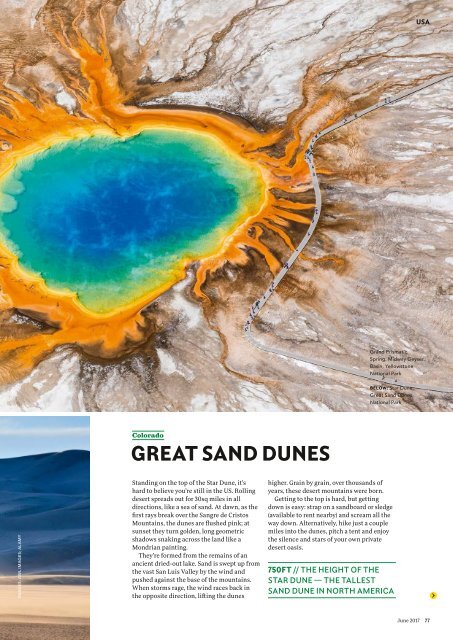National_Geographic_Traveller_UK_June_2017
Create successful ePaper yourself
Turn your PDF publications into a flip-book with our unique Google optimized e-Paper software.
USA<br />
Grand Prismatic<br />
Spring, Midway Geyser<br />
Basin, Yellowstone<br />
<strong>National</strong> Park<br />
BELOW: Star Dune,<br />
Great Sand Dunes<br />
<strong>National</strong> Park<br />
Colorado<br />
GREAT SAND DUNES<br />
IMAGES: AWL IMAGES; ALAMY<br />
Standing on the top of the Star Dune, it’s<br />
hard to believe you’re still in the US. Rolling<br />
desert spreads out for 30sq miles in all<br />
directions, like a sea of sand. At dawn, as the<br />
first rays break over the Sangre de Cristos<br />
Mountains, the dunes are flushed pink; at<br />
sunset they turn golden, long geometric<br />
shadows snaking across the land like a<br />
Mondrian painting.<br />
They’re formed from the remains of an<br />
ancient dried-out lake. Sand is swept up from<br />
the vast San Luis Valley by the wind and<br />
pushed against the base of the mountains.<br />
When storms rage, the wind races back in<br />
the opposite direction, lifting the dunes<br />
higher. Grain by grain, over thousands of<br />
years, these desert mountains were born.<br />
Getting to the top is hard, but getting<br />
down is easy: strap on a sandboard or sledge<br />
(available to rent nearby) and scream all the<br />
way down. Alternatively, hike just a couple<br />
miles into the dunes, pitch a tent and enjoy<br />
the silence and stars of your own private<br />
desert oasis.<br />
750FT // THE HEIGHT OF THE<br />
STAR DUNE — THE TALLEST<br />
SAND DUNE IN NORTH AMERICA<br />
<strong>June</strong> <strong>2017</strong> 77


















